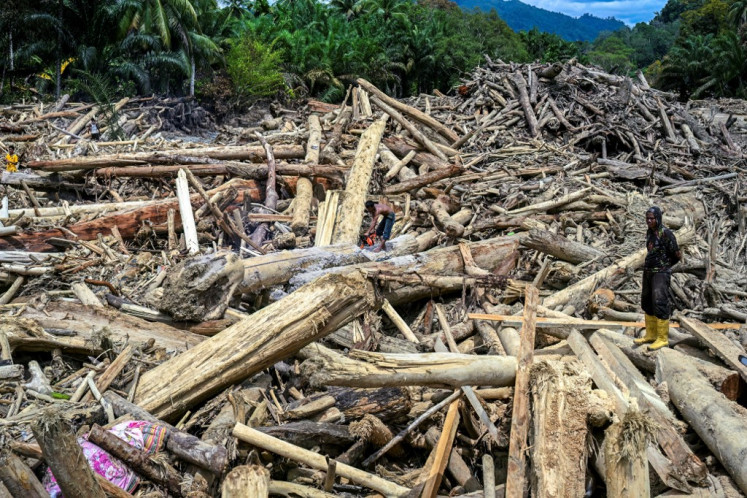Popular Reads
Top Results
Can't find what you're looking for?
View all search resultsPopular Reads
Top Results
Can't find what you're looking for?
View all search resultsAmerica's revised Greenland obsession
Greenland lies across the most direct routes from Russia to the populous east coast of the US, and is the closest territory in the Arctic to both the Russian and the European heartlands.
Change text size
Gift Premium Articles
to Anyone
O
ver 150 years ago, in 1867, the United States acquired Alaska from Russia for US$7.2 million. Since then, it has not expanded its national territory in the Arctic, or for that matter very much elsewhere in the world.
Yet, since 2019, and especially since early this year, President Donald Trump has often stressed a serious desire to acquire Greenland.
The sprawling but sparsely populated Danish territory is almost one quarter the size of the continental US, but home to fewer than 60,000 people, and located in close proximity to the North Pole.
Trump's son, Donald Trump Jr., as well as Vice President JD Vance have made high-profile visits to Greenland in the past two months, and Trump has not precluded the possibility of military action to acquire the territory from North Atlantic Treaty Organization ally Denmark.
What is going on?
Greenland's geographic location is one rational consideration for US policymakers. Greenland lies across the most direct routes, by sea, air or hypersonic missile, from Russia to the populous east coast of the US, and is indeed the closest territory in the Arctic to both the Russian and the European heartlands as well.
These considerations have become especially important in the nuclear age, intensified as the speed of international transport increases.
Not surprisingly, the US occupied Greenland during World War II, and operated 17 military bases there. President Harry Truman also tried to buy Greenland from Denmark in 1946, even as the Danes quietly refused.
Although a substantial US military presence continued during the Cold War, it declined following the collapse of the Soviet Union in 1991.
Today the US maintains only a single military facility in Greenland, the Pituffik Space Base, with just 200 soldiers. And the Danish presence remains likewise minimal, although Denmark in January 2025 announced a $2.1 billion budget for Greenland-related defense expansion, including two new Arctic vessels, together with an expansion of drone and satellite reconnaissance.
The interplay of climate and geopolitical considerations makes a revival of US strategic interest and involvement in Greenland unsurprising.
The Arctic is warming four times as fast as any other part of the world, with prospects strong that warming there could even accelerate, as the ice pack there is relatively thin, compared with the Antarctic, with water rather than solid land beneath.
The opening of the Arctic Sea to the broader world will give Russia, for the first time in its modern history, unimpeded access to open blue waters. This contrasts with the hemmed-in situation it faces in places like the Russian Far East.
Russia occupies two-thirds of the Arctic coastline, and its portion shows prospects of being ice-free much earlier than the Canadian or the US portion of the Arctic Sea.
Russia has been quick to exploit its geo-economic advantages in the Arctic. In 2007, it planted the Russian flag on the ocean seabed at the North Pole itself, and has been quick to claim close-by still frozen seas harboring substantial energy, critical mineral and fishery resources.
Even now, the Arctic generates 10 percent of Russian GDP, including 80 percent of the country's natural gas, one-third of fishery production and 17 percent of Russian oil.
To back up its extensive interests and claims, Russia has established over 32 military bases in the Arctic and had 57 icebreakers and ice-capable patrol ships in 2022. This was more than any other single country at the time, and compared with only five operational in the US.
Russia's assertiveness in the Arctic has arguably intensified since the outbreak of the Ukraine war, with China ignoring international sanctions to expand economic cooperation with Russia there.
In 2024, trade from the Russian Arctic to the broader world reached its highest levels in history. Over half of that trade involved Russian oil exports to China.
The geo-economics of the Arctic, which is believed to harbor a quarter of the unexploited energy reserves on earth, have changed significantly over the past three years.
Russia has intensified economic cooperation with China on the Yamal Peninsula and its environs. Both Sweden and Finland have joined NATO, meaning that seven of the eight Arctic states, all but Russia, are now members of that Western security organization. Three NATO members, the US, Finland and Canada, also resolved in 2024 to cooperate actively on polar icebreaker development.
The Trump administration so far seems to be stressing unilateralism in Greenland more than NATO cooperation as a primary vehicle for asserting US Arctic interests.
Certainly, its designs on Greenland do not sit well with Denmark, nor arguably with the neighboring Scandinavian Arctic states.
And should US-Russian cooperation in the Arctic intensify in the wake of a Ukraine deal favorable to Russia, as Moscow seems to be quietly proposing, that would likely be greeted with Scandinavian ambivalence, and intensified tensions within NATO, as well.
There is one resolution to the building geo-economic tensions within NATO over Greenland that may both further natural US interests in that strategic island, while moderating concerns among America's trans-Atlantic and other international partners about divisions among the Western democratic allies.
And that resolution lies, of all places, in the Pacific. Between 1986 and 1994 the US concluded "Compact of Free Association" agreements with Micronesia, the Marshall Islands, and Palau, three small island nations, and former Japanese League of Nations mandates, in strategic areas of the Pacific west of Hawaii and southeast of Japan.
These allow the US extensive and exclusive military basing rights, in return for economic assistance, market access and open employment access in the US for the citizens of these small and relatively impoverished nations.
Should the US, Denmark and Greenland apply this mid-Pacific model in the Arctic, they could avoid a counter-productive conflict over sovereignty, while assuring NATO security interests and reinforcing international stability as well.
---
The writer is the director of the Edwin O. Reischauer Center for East Asian Studies at the Johns Hopkins School of Advanced International Studies.











